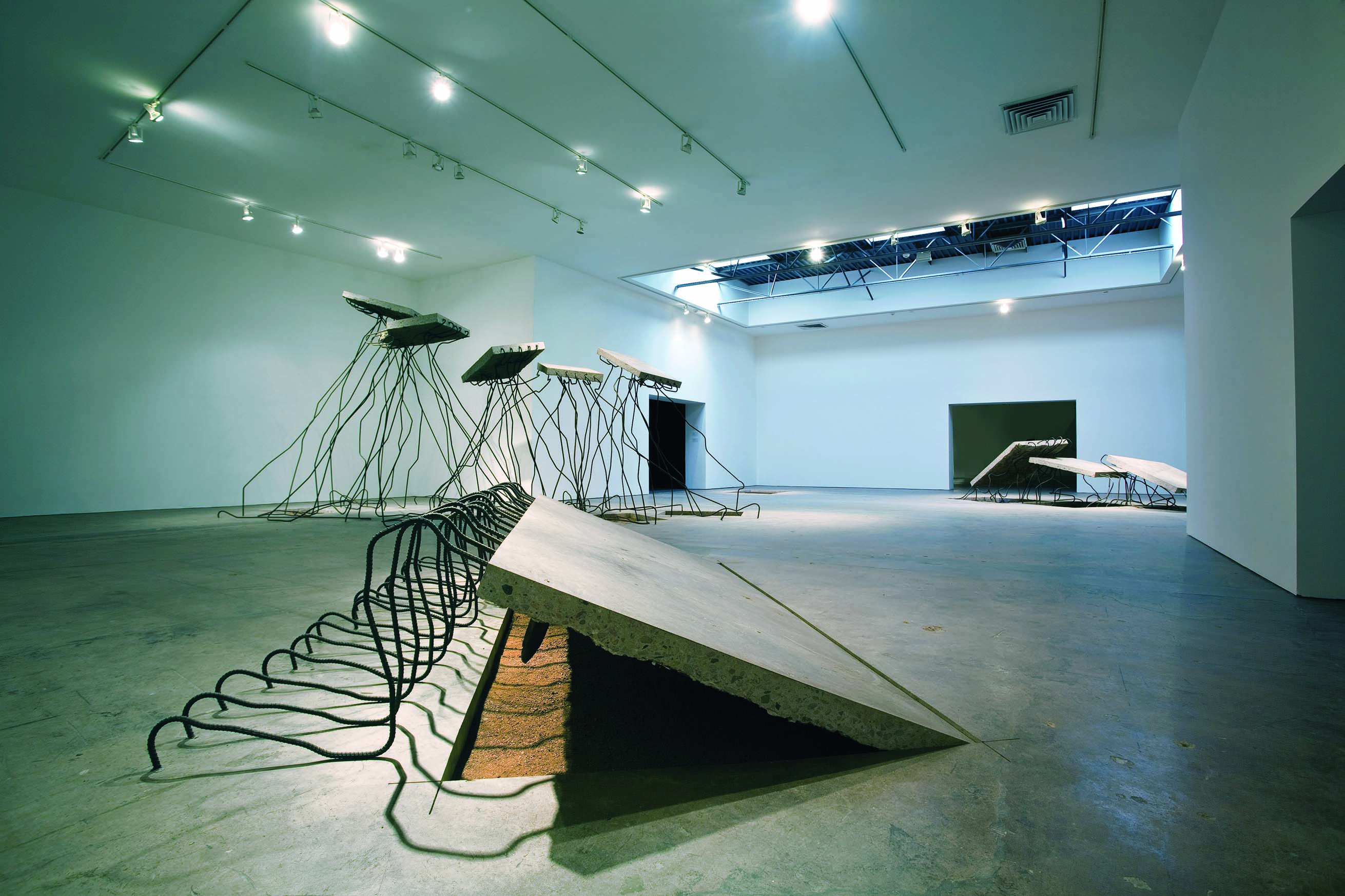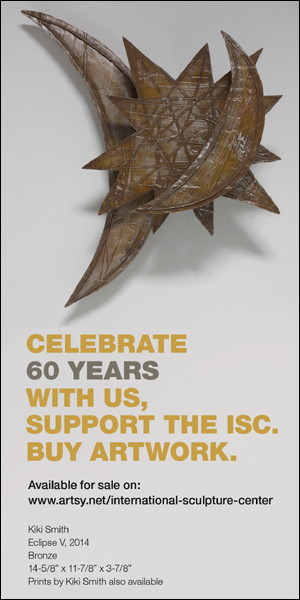Sandra Wagner: You frequently use cement slabs lifted from gallery floors, some raised on tall rebar legs, as in the exhibition “Crooked Under the Weight” at SITE Santa Fe (2009). The site-specific photomural Fwy Wall Extraction (2006–07) alludes to what lies beneath a massive retaining wall, and Extruded Masses (2013) consists of a tower of earthen blocks. How do you see the link between sculpture and architecture?
Ruben Ochoa: “Crooked” featured site-specific works. When you lift up the foundation of a museum space, it’s hard to imagine anything supporting all those histories, and burdened by that much weight, things could get crooked. It was really about engaging the space and believing that the sculpture existed at that moment in time. So, I developed a body of work that cuts into the fabric of the institutional landscape. Some chunks of the old concrete chipped off naturally in the process of extraction, and the sculpture showed that.
The title of one work at SITE Santa Fe, Get off me…I’m not on you! (2009), comes from the push-and-pull dynamic between siblings. That interaction also plays out between an artist and an exhibition space. I wanted to do something that would insert itself into the gallery not simply as institutional critique, that would highlight the give-and-take relationship. It’s as if the pieces were moving from sculpture as an object to installation and architecture as character, animation, and sci-fi.
With Fwy Wall Extraction, I wanted to create an earthwork without physically creating an earthwork. The Los Angeles freeway system is a huge monumentality of concrete and performance—with traffic, there’s a captive audience activating my intervention on a daily basis. So, I created a conceptual earthwork on wallpaper made from a photomontage of various freeway landscapes, printed on vinyl wallpaper and then mounted onto the bare freeway wall. I considered this a momentary adoption of mind, sight, and site.
Once the vinyl was removed, it lifted the pre-existing graffiti off the wall and became a new installation piece, Wallpaper With the Sound of its Own Removal (2008–09). What was once the front became the back, and the adhesive side, with its rich history embedded into it, became the front. Each section consisted of several 22-by-4-foot strips, spanning 50 to 70 feet, hung from inverted fence posts. It was shown with an audio loop of various sounds from the de-installation process—chipping hammers, voices, machinery, and the general hum of cars zooming by.
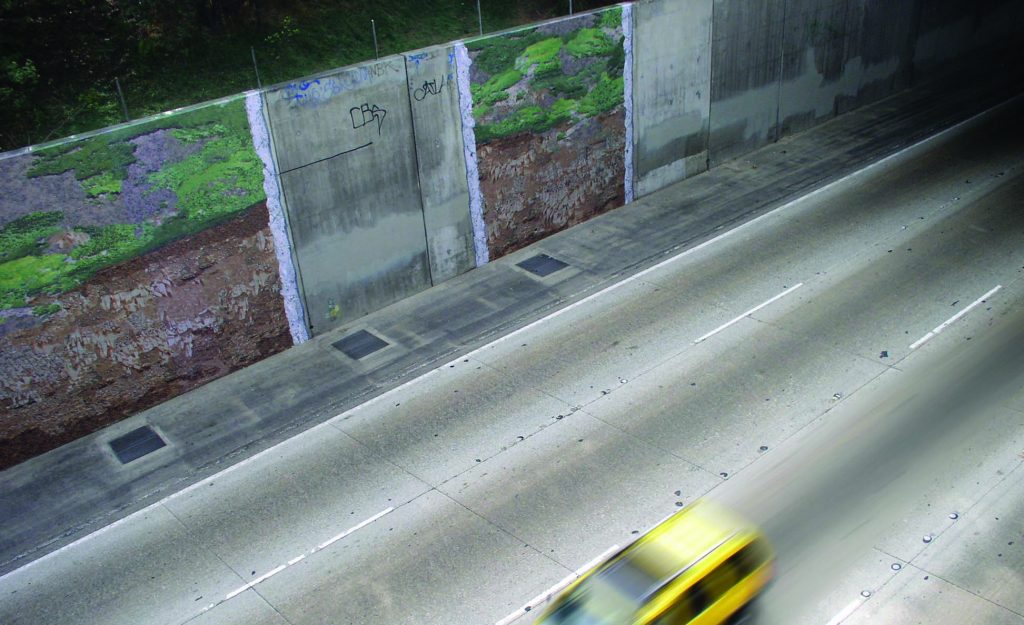
I link my work to architecture in terms of the scale of my materials. Things are what they are—a wall is the size of a wall, rebar is rebar, and pallets are pallets. There’s not much micro-macro in my work yet. Viewers encounter repurposed items and objects with an everyday familiarity because they exist out there in the real world. I guess the twist is how I transform their meaning from its original context.
In Extruded Masses, the works begin to resemble layers of substrata, now in geometric shapes. Basic blocks of dirt dealing with volumetric space, they’ve become an action and a verb just like Folded Architecture. Viewers recognize the dirt, but the visual logistics take them beyond an “aha” moment. Much like intriguing architecture that has become iconic over time, I hope to subversively affect culture in a sublime manner.
SW: An Ideal Disjuncture (2008), the Whitney Biennial sculpture, involved many of the materials that you regularly use: cement, rebar, dirt, wooden pallets, galvanized posts, chain-link fencing. What ideas do you explore with them?
RO: These materials are embedded social signifiers that I attempt to abstract. Whether it’s a roll of chain-link fence coming down and capturing movement in An Ideal Disjuncture or tightly stacked pallets in Building on the Fringes of Tomorrow (2010), there’s a physical toll and presence of labor. Rebar, pallets, and concrete have both formal and informal economic connotations. Here in southern California, the hidden and invisible labor in these construction fields references my own working-class roots. I hope to make that visible by maintaining the sweat equity and use of scale, weight, and raw material.
SW: There is great continuity in your work, including the ideas of movement and transition. While Disjuncture sweeps and undulates, Flock in Space (2013) soars, and If only the world was flat (2013) sheds. Why are movement and transition over time so important?
RO: I intentionally use everyday materials from the built environment that change over time because there’s a beauty in that. Concrete’s going to crack— it’s inherent in the material—and metal rusts over time. I welcome change in the work, the potential of deterioration, the transition that makes the context and content shift.
A lot of my work can look dynamic as a snapshot of a sculptural moment. Some of my interventions only exist as photographs. But movement can happen in the subtlest ways, in the most static-looking works. For If only the world was flat, I mounted several slabs of a cut-out concrete foundation with the underbelly of dirt still attached. What was once horizontal, now vertical, gives a wink and nod to the archaic notion of the earth being a flat plane. Exposing the thin membrane of dirt when concrete is poured is my idea of kissing the earth. Once these 400-pound slabs were mounted, dirt particulates fell over time, creating a nice powder on the floor. That’s the poetics of the piece, since the dust makes you navigate around the perimeter or forces you to step on the grit. It’s not just a visceral experience of seeing the work but also of approaching it.
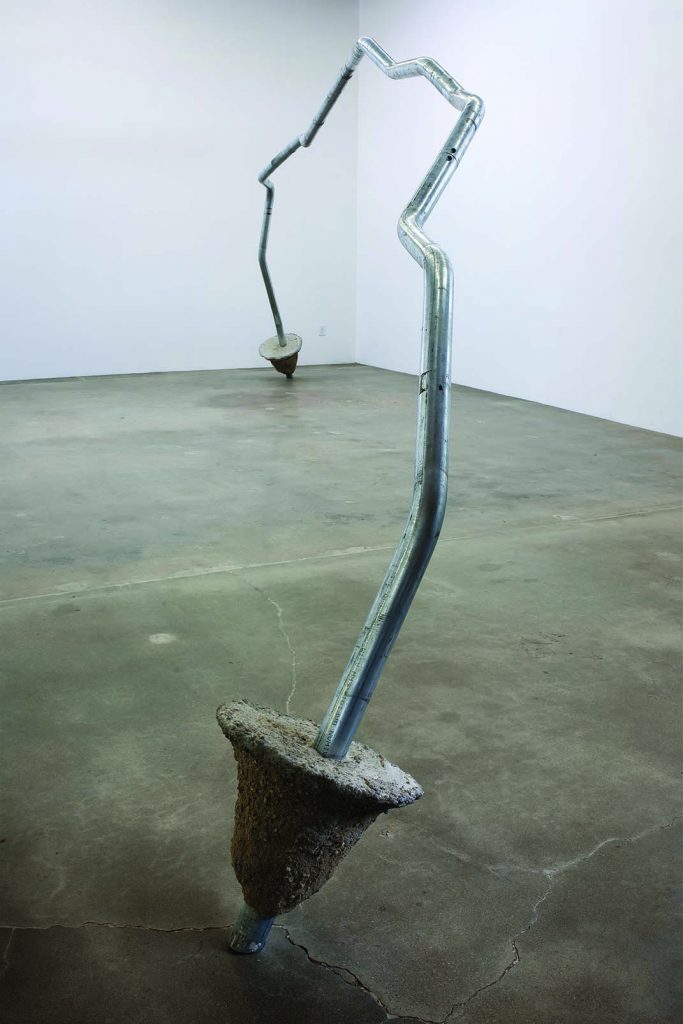
The meaning in L.A. Riots in the Age of Minecraft (re)building block no. 001–006 (2013) has shifted. I moved to Los Angeles in 1993, a year after the riots. When I began producing these works 20 years later, there were still empty lots from burned-down structures fenced off with chain link. The hunks of cored-out dirt and fence posts symbolize this limbo state—a prolonged failure in civic rebuilding. This space signified what was once there, voids. So, how do I core something out of the void? It was like creating a sculpture in which these cores could be building blocks—creating your own environment, like Legos. Since then, the reading of the work has shifted. It no longer points to the riots but to the California drought, probably because everyone’s using fake grass and dirt these days to create their personal xeriscaping. It’s kind of funny how that happens.
SW: There is a tension in your work, formal beauty butting up against raw materials, as in Flock in Space (2013). Considering this work with Disjuncture (2008), how do you see the evolution of the dichotomy?
RO: I enjoy the use of tension. Sometimes it’s subtle, but it is there in other works, such as …that’s what she said (2010), and my rebar and pallet sculptures, including watching, waiting, commiserating (2010). I use tension to suggest action in an otherwise still sculptural object or installation, thereby leading up to the idea of movement and transition over time. Flock in Space consisted of roughly 100 posts. Manipulating 30-foot, galvanized steel posts individually was like drawing in space. I use materials that have social signifiers and try to capture the intriguing aspects in them, just like a flâneur would investigate the city, looking at social divides. Flock in Space played off of Brancusi’s Bird in Space sculptures in bronze and marble, sleek galvanized steel contrasting against rough concrete footings. When the Nasher Sculpture Center invited me to be a part of its citywide 10th anniversary exhibition, I chose the Trinity River Audubon as my site. Before the Audubon Society restored it, that part of the Trinity River was an illegal dumping ground. I fabricated all the bent posts and concrete footings to look as if they came from the old dumping site. The prior references, the quantity produced, and how they emerged from the ground, breaking the horizon line as chemtrails, led to the title Flock in Space.
SW: How have you developed the idea of conflict between natural and built environments?
RO: The earlier works mimicked the city’s fractured neighborhoods more directly. At first blush, the ideas that I mine seem to address land versus man. But for me, all of these landscapes are already manmade constructs with a false sense of the natural. The brokendown parts of a city seem to occur in areas of class distinction. So, I would say the work is less about nature versus the built, and more about the neglect of humanity residing within and contending with the built environment— essentially assimilation and survival.
SW: There is a subtle humor in …that’s what she said (2010) and If I Had a Rebar for Every Time Someone Tried to Mold Me (2007).
RO: Humor catches people off guard, and for just a moment, the social mask they show to the world slips off to reveal the child within. I try to integrate humor every chance I get, whether in the intentional appro – priation of musical phrases in the titles, the placement, or the actual reference of the work. If I could just get viewers to think twice. Whether they love a work or hate it or laugh at it, if the use of humor leads them to drop their preconceptions, my hope is it would resonate with them more.
SW: For a time, your work was anthropomorphized, as in Mi Pobre Corazon (2009) with its intentionally broken wooden pallet, Get Off My Black (2010) with its slumped pile of poured concrete, and hummin’ comin’ at cha (2009) with its spindled rebar legs.
RO: Many of the sculptures started out as conceptual ideas and thoughts on paper. The fabrication maintains the hand of the artist as the work is interpreted from paper to a sculptural gesture. I wanted to take these materials, which are used in a very rigid format, learn how to manipulate and move them, and really explore them. I learned their limits while making the sculptures more organic and playful. In the end, it looked like pieces of the built environment got up and walked away. The pallets in Mi Pobre Corazon and similar works are all cast directly from wooden forms and manufactured in an assembly-line format just as actual pallets are made. Just like wooden pallets, no one concrete pallet is alike.
SW: There’s a science-fiction influence in your work.
RO: I like the hybridization of sci-fi and humor: you can reference social issues in an entertaining way. I’ve referred to everything from “The Twilight Zone” to Asimov. In our media-driven world, we have access to so much art. My intention is to detach viewers from the more obvious heavy signifiers, and hopefully they will walk away with a renewed interest.
SW: There are hybrid qualities to Russet Haze, Opus 1–3 (2015), If only the world was flat (2013), and the three works in Cloudless Day (2014). How do you view the spatial relationships of your two- and three-dimensional sculptures? Were you influenced by Ellsworth Kelly?
RO: I see drawing, painting, and sculpture in conversation. I start with a drawing, practical interdisciplinary work, and it becomes sculptural. I don’t have a specific Ellsworth moment, but he definitely was an influence in my schooling in the ’90s, along with earthworks, Modernism, and Minimalism. At that time, I wanted to be the next Siqueiros. I was painting in a figurative, representational style. After taking a sculpture class, my paintings and drawings became sculptural. I eventually abandoned painting, only to revisit it 20 years later in a more distilled manner. Adding dirt to Cloudless Day is an extension of my drawings. I found myself able to investigate three-dimensional concepts on paper through collage, pounding impressions of rebar on the surface, watercoloring with dirt, or drawing with duct tape. As I continued my sculptural practice with the palette of steel, dirt, rust, dust, cement, and concrete that I had already been applying to works on paper, it made sense to apply those materials to works like Russet Haze.
Contending with one planar surface has been quite liberating for me. The work still deals with space and materiality, and although it’s nice to take a break from the complex engineering aspects of a sculpture, it’s still all about sculpture.
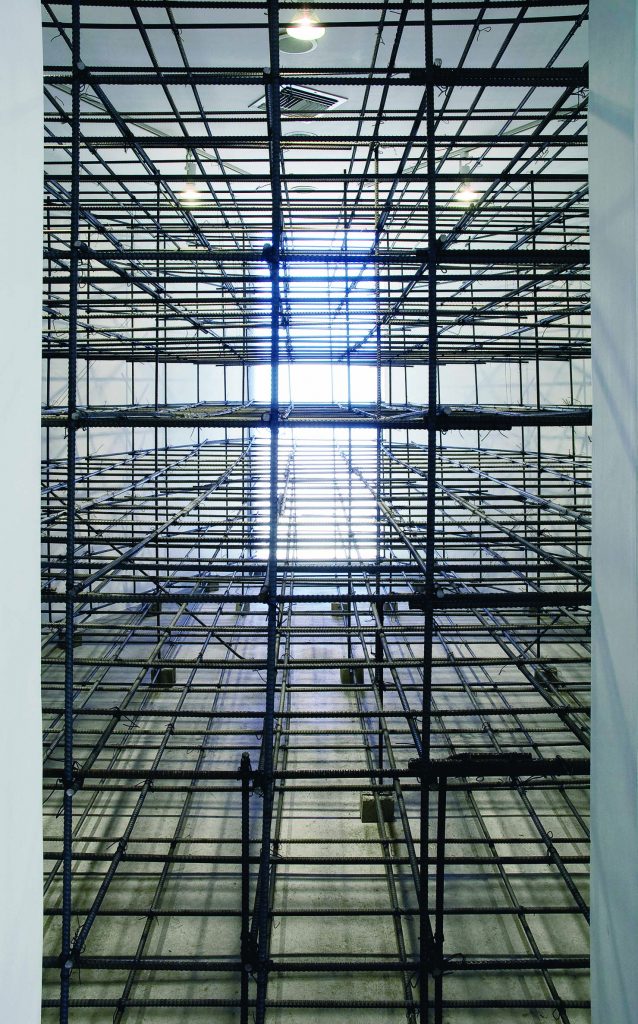
SW: What do you have planned for the near future?
RO: My fourth solo exhibition opened in March at Susanne Vielmetter Los Angeles Projects with low metal sculptures that mimic pulled slabs and folded architecture, where I’m working with form and formlessness, and a couple of large-scale, rust-on-panel paintings. In June, I had two rust paintings in a group show, “Rust Never Sleeps: Growth and Decay in the Making of Art,” at Emily Carr University in Vancouver, where we’re scheduling a residency for next year. I also have a solo show coming up at the Oceanside Museum of Art in my hometown, which looks like it might be all new sculptural works. And in February, I’ll be in the sculptural group show “You Say Home, I Say Place” at the Denver Art Museum.
SW: What artists have influenced you?
RO: When I was in art school learning about art history, there was an apparent gap, which led me to question why there isn’t more information about Mexican or Mexican-American artists. I’m sure there are some out there. So, I always had those issues with art history. Now, when I do works in the built environment, the work is linked to Robert Smithson, Michael Heizer, Gordon Matta-Clark, and Walter de Maria. I found myself relearning a lot of this as I focused on researching and learning about things not discussed in class—funny how I’ve come full circle.
As opposed to rehashing or revisiting a particular art movement, I see myself as if I were an artist of color existing then, and I see Matta-Clark and de Maria as peers. But I deal with work that has a certain social content—invisible labor, the demographic in which I grew up. That’s how I see it, versus the aesthetic. I’m also contending with the white cube, because there weren’t a lot of artists of color allowed in that space. How do I enter into it, how do I become a player? How do I deconstruct it and also be a part of it? How am I implicated in it? At least with post-Modernism one gets to pull from every source to develop one’s practice. I can pull from Heizer, Smithson, my own subjectivity, and, at the same time, Rod Serling and “The Twilight Zone.”
Sandra Wagner is a writer based in Los Angeles.
Watch these videos on Ruben Ochoa and his work



